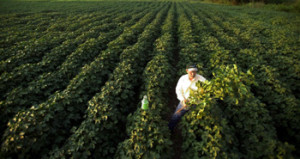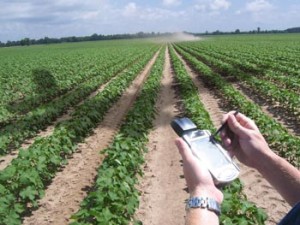New Innovations in Cotton Technology
By Cora DeLeon
 With 2004’s bountiful harvest in the record books, many growers are on the edge of their seats looking to what the next few years might hold. One of the factors credited for the success of the recent harvest is Roundup Ready cotton, a product of Monsanto Company, but could there be an even better product in the works?
With 2004’s bountiful harvest in the record books, many growers are on the edge of their seats looking to what the next few years might hold. One of the factors credited for the success of the recent harvest is Roundup Ready cotton, a product of Monsanto Company, but could there be an even better product in the works?
Since Roundup Ready cotton was introduced in 1997, it has re-defined weed management in cotton production. Now, research and development has set the stage for a new weed management standard—the Roundup Ready Flex cotton system.
With Roundup Ready cotton, spraying Roundup herbicide over the top past the fourth leaf stage was discouraged due to potential foliage damage and reduced yields. However, the new Flex cotton system will allow growers to apply the herbicide over the top up to 30 days before harvest to control economically damaging weeds.
Some of the anticipated benefits of Roundup Ready Flex are increased production efficiency and enhanced crop safety during the plant’s reproductive stage. The Roundup Ready system also provides increased grower income through reduced production costs, reduced production risk, and reduced labor cost.
“Roundup Ready Flex is one of the new and upcoming products that is going to change the way producers grow cotton,” says Dr. Randy Boman, a cotton agronomist with the Texas Cooperative Extension. “Monsanto predicts up to 25 percent of U. S. cotton acres will be planted with Roundup Ready Flex cotton when it is commercially introduced in 2006.” Roundup Ready Flex test plots are scheduled throughout the U.S. Cotton Belt in 2005, according to Monsanto Company.
 Technology is improving cotton genetics, and science is improving the way farmers will grow their crops. A service that is gaining popularity and is available on the market now is InTime Producing Management Solutions. InTime is a patented service that has been utilized since 2003 in many areas of Alabama, Mississippi, Arkansas, Louisiana, and North Carolina. It uses aerial infrared photographs of fields transferred to a computer that analyzes, identifies and locates problem areas.
Technology is improving cotton genetics, and science is improving the way farmers will grow their crops. A service that is gaining popularity and is available on the market now is InTime Producing Management Solutions. InTime is a patented service that has been utilized since 2003 in many areas of Alabama, Mississippi, Arkansas, Louisiana, and North Carolina. It uses aerial infrared photographs of fields transferred to a computer that analyzes, identifies and locates problem areas.
InTime offers four different cotton input management prescriptions including maps for herbicides, insecticides, plant growth regulators, and defoliants. By using Variable Rate Technology with a GPS navigation system, the infrared photographs from InTime give growers an overview of where any or all of these products need to be sprayed. It cuts cost by allowing growers to spray precisely where the product is needed as opposed to spraying an entire field. Aerial applicators and ground sprayers throughout the United States use these systems.
“As of right now, there are anywhere from seven to 10 applicators in the Texas South Plains area equipped with Variable Rate GPS systems,” says David Dewil of Del Norte Technology, Inc. Del Norte is one of the producers of the Variable Rate GPS system. “All a grower needs to do is call local applicators and find out if they are equipped with the system,” he explains. “This system is a computerized GPS system that comes standard in all applicator planes. With our software installed, the system has the ability to read and spray a field according to the map provided by InTime.” InTime recently expanded its services to Texas, Oklahoma and Kansas, and it can be used as often as the grower needs.
“Some growers use InTime three times a year while others use us up to seven times a year,” says Kelly Dupont Director of marketing for InTime. “It’s all a matter of what your crop needs and how often you spray. InTime is price effective and user friendly.”
The service costs $1.50 per mapped acre, and the minimum service is three maps made per season. The infrared photographs are available to the grower online within 24 hours. InTime’s web site does not require special software to be purchased or installed to view the maps and prescriptions on a home or office computer.
Proponents say Roundup Ready Flex and InTime will lead to higher yields, better quality cotton, and improved profitability. They are further evidence that technology will continue to play a key role in cotton production.


